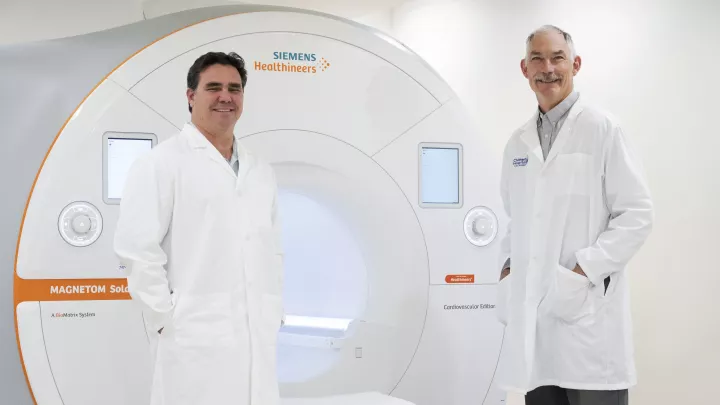Heart Catheterization
A heart catheterization is a minimally invasive procedure used to diagnose and treat some heart conditions.
What Is Heart Catheterization?
During a heart catheterization, a doctor uses an X-ray or ultrasound to insert a thin tube (catheter) into a blood vessel and thread it up the heart. Specially trained doctors perform heart catheterizations in a lab designed for this procedure. This procedure allows the doctor to:
- Measure how well your child’s heart is working
- View any structural defects
- Treat certain heart conditions
Your child’s doctor may suggest a heart catheterization for diagnosis, treatment or both. A benefit of heart catheterizations is that doctors can diagnose and treat some heart conditions during the same procedure. But due to advances in imaging technology, doctors now use heart catheterizations more for treatment than diagnosis.
Diagnostic Heart Catheterizations
Doctors only use a heart catheterization for diagnosis if traditional imaging tests like an echocardiogram or a cardiac MRI do not provide sufficient information to make the most accurate diagnosis. During a diagnostic heart catheterization, the doctor can:
- View heart and blood vessel structure, including any congenital heart defects
- Check blood pressure and oxygen levels in the heart, lungs and blood vessels
- Measure electrical activity and heart rhythm
- See how effectively the heart contracts to pump out blood
- Look at heart valves to see if they open and close properly
- Monitor heart function before and after complex surgeries like heart transplants
- Take a biopsy (sample) of heart tissue to look at under a microscope
Interventional (Therapeutic) Heart Catheterizations
Catheterization is often a less invasive treatment option than surgery. During an interventional heart catheterization, the doctor can:
- Open narrowed or blocked vessels (angioplasty) using a balloon or stent (a thin, hollow tube that holds vessels open)
- Repair tissue causing an irregular heart rhythm (ablation)
- Insert a pacemaker or implantable cardioverter defibrillator (ICD)
- Close holes between the heart chambers
- Replace damaged heart valves
What to Expect During a Heart Cath
Your child’s doctor gives you instructions to prepare for the procedure, including when your child should stop eating and drinking. When it’s time for the procedure, your child goes to the cardiac catheterization lab.
During the heart catheterization:
- Your child gets an intravenous line (IV) for medication. An anesthesiologist gives medication or an inhaled gas to put your child to sleep during the procedure.
- The nurse places electrodes on your child’s chest. These electrodes connect to the electrocardiogram (EKG) monitor, which checks your child’s heartbeat throughout the procedure.
- The nurse cleans the area where the catheter will enter your child’s body (usually the groin). The nurse also shaves this area, if necessary.
- The doctor inserts a sheath (tube) into a large vessel to hold it open. Then, the doctor inserts a catheter through the sheath into the vessel. A special type of X-ray called fluoroscopy helps the doctor guide the catheter up to your child’s heart.
- Once the catheter is in place, the doctor performs the procedure — diagnostic, interventional or both. More than one catheter may be used in electrophysiology procedures. The procedure timing varies depending on the type of heart catheterization and what the doctor finds.
- After the procedure, the doctor removes the catheter and sheath and puts a bandage on the affected area. Your child needs to lie down and keep the leg that had the catheter still for several hours. It may also take your child some time to wake up from the sedative. Nurses monitor your child closely during this recovery period.
- Your child’s doctor gives you instructions about when your child can shower, remove the bandage, and eat and drink.
Heart Cath Benefits vs. Risks
Heart catheterization procedures are generally safe. Some children experience minor side effects, such as bruising, soreness and swelling in the area where the doctor inserted the catheter. These side effects usually go away within a few days. The benefits of heart caths typically outweigh the risks.
Benefits
Benefits of heart catheterizations include:
- Gives the doctor a more detailed view of the inside your child’s heart and blood vessels, which helps diagnose some heart conditions
- Treat some conditions, such as an atrial septal defect (ASD), ventricular septal defect (VSD), or patent ductus arteriosus (PDA) during a single procedure
- Provides a less invasive option than open-heart surgery for treating some heart conditions
Risks
Catheterization involves exposure to some radiation from the fluoroscopy. The amount of exposure is higher than a typical X-ray. Our catheterization labs provide optimal imaging with lower radiation exposure and we are continually updating our systems to further reduce radiation exposure. For electrophysiology procedures, a non-fluoroscopy imaging system is also used to minimize X-ray exposure.
In rare cases, heart catheterization can cause more serious complications, including:
- Bleeding
- Abnormal heart rhythm
- Injury of the normal electrical conduction system
- Allergic reaction to contrast dye
- Vessel damage
- Clot formation or stroke
Heart Catheterization at Children’s Hospital Los Angeles
At CHLA, your child receives excellent care from world-class experts. Learn more about our Interventional Catheterization Program.


